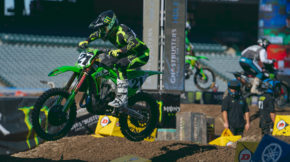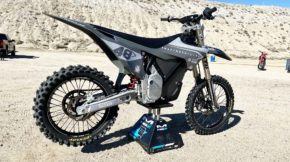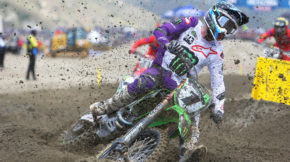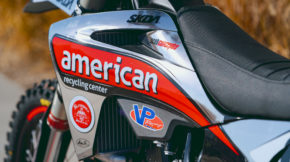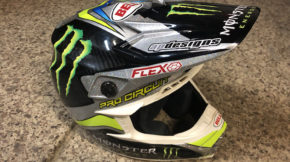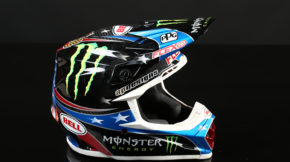Broc Glover | Long Layover At The Airport
Share
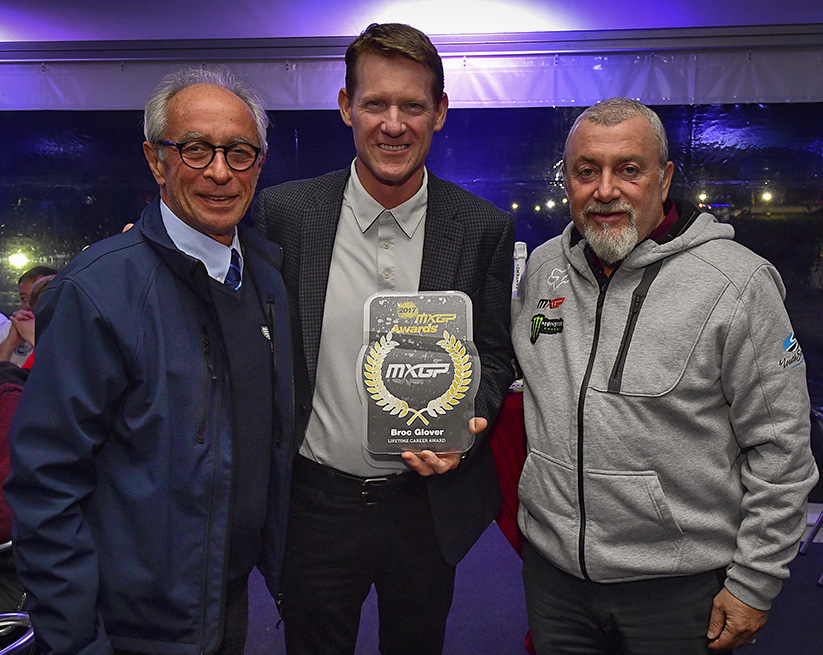
Full disclosure: this actual interview is over a year old. It’s been buried in my phone until the other day, when I found it and finally got around to finishing the transcription of an interesting conversation with one of the sport’s champions and industry’s figureheads, Broc Glover.
I was seated next to Broc Glover on a flight from a race in 2018. The two of us had taken the long route back to San Diego and with a long layover to spend, the Senior Manager Motorcycle, Off-Road, at Dunlop invited me to be his guest at the Delta SkyClub. Broc and I had shared a few conversations before, often in passing during track walk or in the airport early in the morning, but the hours in waiting was filled with talk of the prior day’s motos, his trips to Italy to ride with friends in a once a year event known as TransBorgaro, and life in Southern California. During our last forty minutes in the club, I clicked the recorder on my and I asked him a handful of questions.
To be honest, I know Broc Glover best as “Dunlop Broc Glover.” The six-time champion was well into retirement by the time I began to follow motocross in 1998 and for much of my “career,” he’s been a constant presence in the pits with the company’s black and yellow uniform. So, apologies for not rehashing specific races in detail during this interview. Instead, Glover talked about his path from racing to the industry, works tires, and his appreciation for the sport.
What goes through a racer’s mind when they face retirement, the storied PROTOTYPE tires of the Bridgestone-Michelin-Dunlop days, and how higher-ups in key companies view the industry are things that always have been interesting to me, so it was interesting to hear from a person that checks all three boxed. When it was time to board our flight, Broc boarded with the rest of the First Class passengers. By the time I got in with an okay, but not great “status” group, Glover was comfortable in his seat at the front of the plane.
When you started winding down your racing career, did you know tire development with Dunlop was something you could do or was it something you fell into?
When I got done racing, the very end of my last full season, was 1989. I’d been in Europe for a year, I traveled back and forth and probably never stayed more than a month at a time on any given stretch, but I would come back for a week to kind of recharge and go back over. But when I was done, I would say I was tired. When I finished racing, did a couple small international races, and then after that, I pretty much put up the boots and helmet and didn’t really do much riding at all, didn’t do much in the sport at all. And I really didn’t go to too many races for many years, actually. And then after, I don’t know the stretch of six, seven, eight years, I kind of felt like I got my batteries recharged. I didn’t come back into the motorcycle industry until about 1997.
When you make something your life and career, then you get a chance to get away from it, it’s pretty common for someone to take a break and then come back. Did you find out that your appreciation for the sport had grown in your time away? Did it seem like many things that changed or was it still motorcycle racing?
I knew I needed to recharge my batteries, no question about it. I mean, the last few years of my career were certainly frustrating to me, personally. I had multiple injuries and had times, in my opinion, and I think in some other people’s opinions too, on less than competitive motorcycles, which is always a frustrating thing. I still wanted to win and maybe I wasn’t in a position to do that as good as I could have. When you’re in that position, it is frustrating. And then I had a couple of injuries on top of another injury. And as soon as I would come back, it seemed like just a few months later, another injury. And that was not something I had in my career, I actually was very injury-free for the majority of my career. I had won championships and things like that, I was pretty injury-free. I definitely needed my batteries recharged. When I came back into the industry, I always appreciated everything and still to this day am unbelievably grateful for what the sport has given me. It’s pretty much given me everything I have in my life, from people that I know from lifelong friendships I’ve developed, and it’s opened the doors to meet many, many different people from different walks of life that are fans of the sport. Motocross has pretty much given myself and really my family, most everything we have in our lives. So I’ll never forget that.
What was the first job when you came back? Was it always with Dunlop?
No, I actually started as Brand Manager at PJ1, that was kind of my first introduction back. PJ Harvey always had been a friend of mine in the industry and somebody that I felt what was a solid business-minded person, which always interests me, the business side of motorcycling. I was looking for some way to get back into it and for many years he told me, ‘When you get done racing, why don’t you come work with me? You will have fun.’ And so after I felt like it was time, I took him up on his offer and I went to work for PJ1 for two and a half years.
It was just after when they were the title sponsor of the racing team, but the title sponsor of the Arenacross series. I helped transition more from just the Arenacross and back into Supercross. I worked in more than just the racing side of things, I actually did a lot of traveling with the reps, going to events and shows. There were quite a bit of other things involved being a brand manager as opposed to just a race support person.
Was that the only job you’ve had or had there more between that and Dunlop?
I actually worked for No Fear for a couple of years and it had nothing to do with motorcycling and motorsports at all [Laughs]. That was up until I went to work for PJ1, from about 1995 to 1997 or so.
I worked in the sports marketing division and actually helped them start what was going to be a golf division. They were branching out to many different sports at the time and unfortunately, just some things happened within the company that caused them to regroup, scale down and basically just cut everything out of the program other than the core sports. They cut out baseball and football,
They kept surfing and motorsports, cut out the rest of the peripheral sports and golf was one of them. But it allowed me to get back in the motorcycle industry, which is where my heart really was.
How did you learn about sports marketing? Was it something that had interested you for a while or something you picked up?
If you think about a company that was a good one to get your feet wet, No Fear if you looked at it from a 50000-foot view, I guess they were a marketing company. Anybody can make a T-shirt and print something on it, but it’s what’s printed on it and what that message says either with a logo, a brand, or what’s associated with, that is what differentiates companies. No Fear had a message that they sent through their whole brand. They were a marketing company. I learned a lot by just listening and hanging out with the people that founded the company, with the people that were running it. It was a really good experience for me.
Okay, so from No Fear to PJ1, to…
I just happened to be at a motorcycle event for Parts Unlimited, the Colorado 300 event. During the course of a conversation with Mike Buckley at Dunlop about the business in general and career paths, he asked me if I missed being involved more directly with racing. And my answer was yes. He must have had something in mind and over a period of time, we talked a few more times. And here he asked if I still had the interests that I expressed during our conversation. And I said yes. Our conversations led to a little more detailed conversation and he happened to have a position in his company that was unfilled, a new position, that kind of seemed like a perfect fit for me. So was a nice opportunity for me and I’ve never regretted it. I mean, if you ever have the opportunity to work for our company and like the industry, I can’t say enough about what a great company it is to work for.
The big thing that everyone thinks, at least in our space, is that Dunlop is a motorcycle tire company, but there are so many facets to it. With any tire company, automotive and motorsports are different, and Dunlop is much bigger than just the MX3S. There are the golf divisions and everything else.
When I started, it was shortly after the joint venture agreement between Goodyear and Dunlop tires, and there are multiple divisions. There’s Goodyear Dunlop Tire Europe, there was Goodyear Dunlop Tire North America. And then there was Dunlop Japan, which was primarily owned by Sumitomo Rubber, which is in my world is SSRI and Sumitomo Industries. And Sumitomo is a major conglomerate in Japan. They own banking and real estate and we fall under the chemical company’s division, so our tire and rubber falls under their belts. And they’re the ones that we use primarily for the motocross tire developments. The majority of our tires we sell in the motorcycle world are actually made in Buffalo, New York. They supply street tires for Harley-Davidson, the original equipment and replacements, and all of the sport bike tires, so almost everything’s made in Buffalo, New York, which is unique because it’s truly the only tire company in a motorcycle world that makes tires for the United States. With the exception, I believe there’s a new one starting up to make some U.S. tires, too. So that’s a nice thing, to have something made in the U.S. That all being said, our motorcycle division in North America is now back underneath Sumitomo Rubber; they own a brand in golf called brand called Srixon and it’s a pretty major brand in the golf world. But although we have relationships with the Cleveland and Srixon, it’s really not part of our world. The Falcon Tire brand is the car tire brand that Sumitomo runs, so many people remember Falcon Tire for having a relationship with Supercross and with Ryan Villopoto, being one of Ryan’s personal sponsors.
The Dunlop Motorcycle Division within our company is made up of around 20 or 25 people, and almost 95 percent of them are core motorcycle enthusiasts. That’s what’s so nice about being in our company, that almost every single person is either an enthusiast themselves or are from multiple generations of motorcycle fans and participants. Rob Fox, who runs our amateur vision, his parents on a motorcycle dealership and you’ve got guys whose parents were reps for major distributors in our industry, so they went into that field, too. So almost everybody rides or is passionate about motorcycles and it runs deep within our company.
What is your exact job title?
I am the senior manager of the Motorcycle Off-Road and primarily, I’m in charge of all of our racing activities that touch the dirt, hence the “off-road.” That being said, I certainly do the best I can to give feedback and input whenever needed for product development. I don’t have product development input on the street side of things, but in any off-road area, I always gather the input from whoever is working with the amateur riders and the professional riders. We try to put it together and apply it to what we’re trying to develop in the future or for the production tires, marketing-wise. For a company like Dunlop, that is so passionate about racing, our racing activities interject with our marketing message. Because of that, the racing side of things drives a lot of our marketing and our off-road tire sales.
As far I can tell, you haven’t missed a race in quite a while. And you get there early, too, so you’re not just a guy who shows up on Friday night and leaves first thing on Sunday. You, Fleck, and the rest of the team have busy days from Thursday until Saturday night. What does a weekend consist of for you?
We have a semi that services the races at the professional level and we also have one for the amateurs. As much as we probably get more notice in the general media on the pro side of things, our amateur side of things is equally, if not more so, important that the pro side. Our truck drives, as many of the team’s trucks do, from event to event. But ours usually has to stop and restock in between races, which adds a little bit to the logistics that the other teams and companies don’t have to deal with. So, the trucks usually arrive on a Wednesday and get ready for Thursday, when they into the pits and setup with Brian Fleck and the crew. Brian has worked for the company for 31 years, so he’s got a lot of experience. They pull in and do the setup, and I usually fly in on Thursday. I also do a Dunlop Motorcycle Tires “Track Condition” report that we shoot on Friday that gets aired on Supercross Live’s video, then talk to the teams and do whatever we need to do on a Friday so that we’re ready on Saturday for the races. Brian and the crew usually fit the team’s tires and around 90 percent of the riders use our product, so we have a fairly busy schedule making sure all the teams and riders are set up for whatever the track conditions are. We try to have the appropriate tires ready for them and then perform the events throughout the day. I have different responsibilities, everything from opening ceremonies on and then I watch the races and see what happens, then listen to any positive or concerns about tire performance from the teams and riders.
Is Brain more on the technical side and then you communicate everything back to the corporate level?
Absolutely. Brian’s official title is “Technical Manager of Professional Off-Road Racing.” Brian is absolutely the nuts and bolts guy, and he can tell you exactly what the feedback of each of our riders is in between practice sessions. He goes and gets input from each of the riders. It’s primarily with a factory level team or with factory-supported 250 teams. He might talk to anywhere from 15 20 riders between qualifying sessions and the race, and after the race. He goes by and checks with the teams and makes sure is everything’s okay. Then Brian produces a race report that gets distributed amongst our internal people, plus get sent to Japan for them to look it over for any concerns or any requests from the teams. Brian takes care of that at the professional level and we have an amateur manager that takes care of the amateur level. They all have input in our overall product planning and future product development, so it’s a pretty good and cohesive team.
I think that people see tires and think, “The black rubber and the shape is always going to be the same.” The knobs and tread patterns will always be different, but how much have things changed in the last 15 years, from the two-strokes to the four-strokes? The sport keeps evolving, you guys have come out with a lot of stuff in a really short time, and every Saturday is a test.
You know, to me it’s amazing. I still have a lot of passion and heart, and in the last few years, I really enjoyed the vintage events, too. Vintage motocross in the U.S. seems to be growing and growing and I try to attend more and more of those events. When you talk about how tires evolve, they’re so much better than what we used to race on 20 and 30 years ago. It’s night and day. It’s the same as the motorcycles, how phenomenal the advancements in the motorcycle side of things have been, the tires have kept right up alongside them. If you think about a tire, it’s the only thing that moves the motorcycle and touches the ground, and it’s an intricate part of the suspension system of the motorcycle. And that’s probably one of the biggest things, how a tire can affect the performance and how the suspension reacts across the ground. And these riders, especially at the pro level, are at the microscopic detail of what they’re seeing. And some of it is the data, the data that’s available from their team and crew that the deciphers what they’re figuring out on the motorcycles. I’m not 100-percent sure that the rider can feel all those little minor changes or the differences, but certainly, they can see it on a computer screen. They make sure that no stone is left unturned and that any time they’re changing a tire from one to the other, they know how it affects the motorcycle overall.
So that being said, look at the modern motocross tire and it’s so much better than it used to be. I mean, we have knob within a knob design for better performance with more aggressive tread patterns but are still having fantastic performance in hardback conditions. We have different rubbers on sidewall versus the tread rubber, where it’s an anti-bounce sidewall to help the bike not deflect off of bumps and maybe stay on the ground for better traction. You’re engineering different flex points in the tire to take the stress away from the knobs, especially in the supercross in the whoops which is so hard on the knobs, because the guys shift up a gear and spin the tires so much. It’s almost like a miniature panic rev between each whoop to bring the rear-end of the bike back down to drive forward, which ultimately is very hard on tires.
The best thing you can possibly do to a vintage motorcycle is put a brand-new modern tire on it because it helps the suspension, it helps the traction, it makes the bike perform better. It’s the cheapest and easiest thing to do, instead of going trying to chase all the suspension and all the different things that you do. It has its limitations and rule limitations or even design limitations. I mean, the suspension system that was designed in the 70s and 80s is certainly not going to be modern by any means. You can change the internals of the suspension to a point, but you can’t change the spots on the leopard. Any vintage person I know, I always tell them to put a brand-new set of modern tires on your bike and you’ll be happier than anything else you’ve done. It’s good that the tires have come a long, long way from where they used to be. We certainly have the luxury of our relationships we’ve developed with the factory teams to have the feedback and input of the smartest people in motocross, from the best riders in the world to the smartest technicians in the world. Being able to get that feedback and information from them helps us in their quest to develop better tires.
So one thing that Dunlop is not shy about is running a prototype tire on a bike at any given race. And then the next week you put the board out that says, “This is what the podium ran last week.” How important is that for Dunlop to bring something Saturday that you know is one step further for fine-tuning. It’s not something someone can go buy, but eventually, you’re trying to get the tires to that point.
Well, one of the misnomers is that there’s a lot of stuff out there that’s right off the shelf. Plenty of the riders that are running around in the top-10 are on off the shelf product. But on the other side of the coin, we would be fools to not use the top guys for feedback to develop next-generation tires. Many times, what you see on the track, either one year or early in the season, you’re going to see on the shelves at a local dealership within a short period of time. And as with any company, you have life cycles for your product. It doesn’t take a genius to figure out that when a tire has been out for multiple years, it’s probably not far away from a new product cycle coming in. You can kind of look back at our company and you kind of realize once they’ve had a tire out for X amount of years, there’s probably something new coming. We always want to be able to say that we’ve race-tested our product at the highest level and I don’t see that changing in the future. Sometimes I do read things in social media or somewhere, people act like it’s a negative thing that we don’t always run exactly the same tire that you can buy. But if you tested them both back to back, I can comfortably say that if you take the tire that would be on Eli Tomac’s motorcycle or Marvin Musquin motorcycle, and test different production tire against it, I would say that 90-percent of people in most conditions couldn’t feel the difference. Yeah, it might be that 10-percent. And in the past actually at one point felt like we could offer something for the public that we called the “Race Replica.”
But the reason the Race Replica tire has not resurfaced is primarily that we honestly haven’t been able to make that much of a difference with a race tire versus a production tire. In the past, it seemed like we could make two or three seconds a lap in certain conditions and now it doesn’t seem to be quite that big of a difference. Would it even be worth bringing that out when most people couldn’t feel the difference? I can’t go by the exact front suspension that Eli Tomac has on his bike or the engine that Marvin Musquin has on his bike, because those factories also use special products. Sometimes they’re special because the material is cost-prohibitive to manufacture for production, it would make the bike cost 30,000-dollars. KTM tries to do something like that with the Factory Edition and they do charge a little bit more, but you get a little better bike. Some of those development products that these teams are using, they’re learning from. It might not necessarily be a titanium footpeg of that exact design, but they did learn that they could reduce weight and not lose any strength or something, all by designing something different that they figured out at the factory level. Tire companies are no different. The motorcycle companies and us racing to better our product, and you’re selling your racing product. Motocross tires are, no question, are racing products. They’re closed-course tires and that’s what they’re designed to do, help you go faster around the track.
A big think that you guys have is that Dunlop comes OE equipped. I mean, there are maybe a handful of bikes that have another manufacturer’s tire, but I would say 90-percent is from Dunlop.
And I’m proud of that. For KTM off-road line, a lot of them come with Dunlop tires now, and that’s a relationship that I actually helped get started way back when Rod Bush was still alive; During one of my first trips to Austria with many old friends that I still had a KTM is when we started talking about it. It’s helped us come out with a better product, it’s helped their product be better to the general public because they feel like it comes with a quality tire on it. The Japanese have always had a good relationship with Dunlop.
For ODI or Pro Taper, they get to be the standard equipment and that’s a huge selling point for them, because for some people that’s their first introduction to the brands. And they’ll keep going back to buy them if they have a good first experience. For Dunlop, most people think, “This tire lasted a long time. It does exactly what I needed to do. I’ll keep putting these on, instead of chasing something that I’m not sure will work.”
I mean, it’s a fantastic point that you make. I mean, years ago, the first thing you did with a new bike was you threw away the handlebars on the bike that it came with because they were steel, not even a good Chromoly. They bent really easy and in the first crash you were going to bend them. Now all the manufacturers’ motorcycles are amazing stock. They’ve got good tires on it, they’ve got good handlebars and grips. Unfortunately, the aftermarket companies, it’s not as easy for them to improve upon the product, but there’s no question about it when you see a bike with quality products on it, it may be the handlebars and might be the tires, you feel like the bike has a more quality and the manufacturer cares more about the product they’re putting out to the consumer.
One thing, and this might be more of a Brian question, is the metal starting grid. Has that affected you guys? Most pro racers aren’t going to run the whole day on one set of tires. But with the metal grid, when they dump the clutch, is that pretty rough or are you guys going okay with that?
No, it is a little harder on the tires, no question about it. It’s not as bad as we thought it was going to be is probably the honest answer. By using high, high speed or slow-motion video, you can certainly see there’s not nearly as much wheel spin on it. If bike spun the tire more, it would tear that tire up more, but the fact is they actually don’t spin that much. It’s just a little bit of slippage is what I want to call it, as opposed to actually spinning the tire. It’s really not as bad as I expected. It’s a little concerning me on a personal level, in that I just don’t like seeing anything that makes our sport more expensive. And I feel like at the Triple Crown events, for instance, most privateer riders are happy to be able to afford a new set of tires when they show up at a Supercross race. They’re scrounging just to get from race to race and doing it on a shoestring budget in most cases. The last thing they want to do is if they do make the Main Event is to have to ride, a free practice, two qualifying sessions, possibly an LCQ, and then have to go out there and ride three Main Events. They have the potential of dropping the clutch five different times on that metal grate with the same rear tire, where the factory rider has the chance to change it all three times. So I just don’t always like to see the costs go up. Many of the privateer guys, whatever they race on the weekend, that’s what they practice on during the week, and then they put a new one on for the next race. Well, if the tires pretty well chewed up from five starts on a Saturday, they’re probably not going to be practicing on it. It hasn’t been as bad as I thought it could have gotten, but again, it’s just anytime the sport gets more expensive, I just I don’t like to see that. Because I think it makes it more prohibitive for more people to participate.
A big thing that Dunlop takes pride in is the testing facility in Alabama. How hands-on are you in that, or is it a completely separate department?
When I first Dunlop, I remember going down there and riding there. We had a dirt bike track in the back and we had a street oval that you could throw water on to test the wet performance of tires. It was a car and motorcycle facility, but it’s now pretty much gotten away from that. We recently invested a significant amount of effort and time and now it’s state of the art. It’s been very invaluable for our company. Over the years, we hired Mark Burnett to come and build a close to regulation supercross track, but they’ve toned it down just a little bit. We hired Clark Stiles, an ex-professional and top 100 rider, to come in and Clark is our chief test rider. Danny Roberts oversees the whole entire facility. Danny was a road racer that raced Daytona and other places many, many times and he’s also a fairly good motocross rider himself. So we are able to do controlled testing in our own environment and a consistent level with the same riders during the testing over and over. It gets very consistent results that we can really rely on. We also use a lot of amateur and other riders to test our product as well, as we talked about earlier with the top pro level and the best riders in the world. We feel like this three-sided approach is pretty good to know to have the amateur riders, the everyday weekend warrior riders, the pro riders, and then our own testing facilities. I think we do a pretty good job of testing our product before it gets out to the consumer.
As a guy that started riding as a kid in Southern California, are you ever surprised at some of the things motocross has given you? There are kids that are named after you. You retired before I was really into this, but I know your career and it’s cool to see when people walking around. You’re one of the few guys to get recognized in a paddock every week for your accomplishments as a racer. How does that feel for you?
I think it’s neat. I mean, neither of our kids are into the sport, our daughter probably follows it more than our son. But when we do take their friends to a supercross race or something, and there might be Broc Tickle out on the track or there might be some other guy. I remember one time we talked our neighbor and she’s like, “There’s like three or four, five riders named Broc out there racing. That’s interesting.” I don’t think it ever dawned on her that, “Yeah. That name.” I remember meeting Broc Tickle for the first time with his parents, also Broc Hepler with his parents before that. And yeah, it’s truly a tremendous honor. The parent sometimes they just like the name and other times they actually know, “You were my favorite rider. I always respected you as a rider or as a person.” And that’s a tremendous honor, to have somebody tell you that they would consider naming their child after you for whatever the reason be. Do I ever get tired of here? No, not at all. I mean, I’m truly honored and I think it’s neat. I guess I was just fortunate. My mom kind of had a little bit of a unique name and so it stuck. When you look, there’s at least one. I remember a couple of races at Nationals there was, you know, three or four or five of them entered in the two classes. And it is really cool. I always keep an extra eye out for somebody out there with that name. So it catches my attention, no question about it.






















